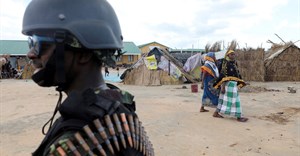This report, published by courtesy of UN-HABITAT, summarises the influx of rural dwellers into the cities of Africa. The influx promises dramatic urban growth that will not only present challenges, but also opportunities for business.
• Globally, urbanization levels will rise dramatically in the next 40 years to 70% by 2050. More than 70% of the populations of Europe, North America and Latin America are already urban. Asia and Africa remain predominately rural, with 41% and 39% of their populations living in urban areas, respectively.
• However, if current trends continue, half of Africa's population will be urban by 2050. Africa will have an urban population of 1.2 billion, or nearly a quarter of the world's urban population.
• The rate of change of the urban population in Africa is the highest in the world. Despite some signs that urban growth is slowing down, the potential for further urbanization is still huge: the region is in the early stages of its urban transition, with an estimated 38% of its population classified as urban; urban growth rates in Africa are the highest in the world (3.3% per year between 2000 and 2005) and are expected to remain relatively high; and fertility rates in 2007 were still high (4.7%) compared to the global average (2.5%).
Growing cities
• The main cause of urban growth in most countries is natural increase - when births in cities outpace deaths. In countries with low levels of urbanization, migration is often the primary engine driving city growth, as is the case in various countries in Africa and Asia. In many countries, the largest movements of population are taking place between cities and not from rural to urban areas.
• Urban-to-urban migration is also becoming more common in African cities. In South Africa, approximately 3 million urban residents have migrated from one district or metropolitan municipality to another in the last five years.
• A common historic pattern observed in virtually all developing countries is urban primacy: the concentration of a significant proportion of the national urban population, and the control of flows of capital, financial transactions, industrial production, national revenue, and other similar indicators in one city. But urban primacy is also bad for business - it distorts the economy, creates imbalances in the distribution of populations and resources and gives rise to different forms of socio-economic disarticulation.
• The highest growth rates for primate cities were recorded in Africa (3.65% per year), including in Nairobi, Kenya; Niamey, Niger; Dar es Salaam, Tanzania; and Lomé, Togo, all of which grew at an annual rate of 4% or more. Kigali, the capital of Rwanda, is the only primate city that experienced soaring annual population growth of 8.6% from 2000 to 2005.
Shrinking cities
• In African cities, signs of decline are almost negligible. Some urban areas, however, are either experiencing slow growth or are suffering from population loss. This phenomenon is confined mainly to small towns and cities. The UN-HABITAT analysis of urban growth from 1990 to 2000 reveals that of the 11 African cities that experienced declining populations, 10 were small cities. It is possible that some cities lost populations as a result of war, disasters or civil conflicts, but in most cases, population loss has been a transitory process. Recent studies on migration and urbanization in Africa have produced empirical evidence demonstrating new patterns of return migration from urban to rural areas that may have an impact on population decline in the future.
For richer or poorer: Urban inequalities
• Many countries in the developing world are enjoying rapid, positive economic growth, but a large majority of their populations are not benefiting from the new wealth. Income inequalities in cities are generally high, with some regions, notably Africa, exhibiting exceptionally high levels of urban inequality. African countries in which cities exhibit extremely high levels of inequality are Kenya, Namibia, South Africa, and Botswana.
• Sub-Saharan African countries have the highest levels of urban poverty in the world. Although rural poverty is pervasive in the region, more than 50% of the urban population in the poorest countries lives below the poverty line. Poverty often manifests itself in inequality in access to adequate housing. In 2005, six out of every ten urban residents in the region were slum dwellers - nearly double the proportion of the rest of the developing world, and four times that of Northern Africa, where slum prevalence is approximately 15%, and where slum growth is slowing.
• Northern Africa, on the other hand, shows a relatively egalitarian pattern of income distribution. The differences in urban poverty and slum prevalence between Northern Africa and sub-Saharan Africa are reflected in the distribution of income, with the former having a moderate urban Gini¹ coefficient of 0.37, compared with urban sub-Saharan Africa, where the Gini coefficient has an average value of 0.46, above the international alert line of 4%.
• Freetown in Sierra Leone, Dire Dawa in Ethiopia and Dar es Salaam in Tanzania are among the most equal cities in sub-Saharan Africa, with Gini coefficients of 0.32, 0.39 and 0.36, respectively.
• In urban Kenya, for instance, the Gini coefficient rose from 0.47 in the 1980s to 0.575 in the 1990s largely as a result of Structural Adjustment Programmes poor governance and other factors that adversely affected the urban poor.
• In Nigeria, the urban Gini coefficient increased from 0.37 to 0.416 for similar reasons, and in Abidjan, adverse economic conditions culminating in the devaluation of the currency provoked an increase in the income Gini coefficient from 0.497 in 1992 to 0.529 in 1998.
• In South African and Namibian cities, inequalities are most pronounced and extraordinarily high, despite the dismantling of apartheid in the early 1990s. In fact, urban inequalities in these two countries are even higher than those of Latin American cities.
• The average Gini coefficient for South African cities is 0.73, while that of Namibian cities is 0.62, compared to the average of 0.5 urban Latin America. Maputo, the capital of Mozambique, also stands out as a city with high levels of consumption inequality, with a Gini coefficient of 0.52.
• Surveys in 17 small cities and towns around Lake Victoria in the three East African countries of Kenya, Tanzania and Uganda show that levels of inequality in these towns are almost the same as those of big cities, largely because of high urban growth rates that are not accompanied by increased provision of infrastructure and basic services, such as water and sanitation. The Gini coefficient for income in these towns did not vary much between countries (0.56 for the Kenyan towns, 0.57 for the Tanzanian towns and 0.55 for the Ugandan towns).
Inequalities in access to education and employment
• This is true in several of the countries included in UN-HABITAT's analysis, especially in Western and Central Africa: Benin, Burkina Faso, Central African Republic, Chad, Comoros, Cote d'Ivoire, Ethiopia, Guinea, Mali, Mozambique, Niger, and Senegal. In all of the countries analyzed here, more than 75% of the children of primary school age in large cities attend school, but in rural areas, the proportion drops to less than 50%.
• This pattern is most pronounced in Niger, where 73% of children in the capital city attend school, compared with 17% in rural areas; in Niger's small cities and towns, 53% of children of primary school age are enrolled.
• In countries such as Senegal, Mozambique and Niger, there are more jobs and schooling opportunities in small cities and towns than in large cities. For example, in Senegal's large cities, 41% of young women are neither working nor attending school, compared with 33% in small cities and towns. The non-employment rates are 30% in large cities and 21% in small cities and towns in Mozambique, and 51% and 40%, respectively, in Niger.
Slums
• Nearly two-thirds (62%) of city dwellers in sub-Saharan Africa live in a slum. This proportion is particularly high in countries such as Ethiopia, Angola, Central African Republic, Chad, Guinea-Bissau, Madagascar, Mozambique, Niger, Sierra Leone, and Sudan, where slum households are likely to lack clean water, improved sanitation, durable housing or sufficient living space; in many cases, slum dwellers in these countries not only suffer from one shelter deprivation, but from three or more.
• A second group of countries in sub-Saharan Africa has large slum concentrations but fewer instances of multiple shelter deprivations. Among these countries, are Benin, Burkina Faso, Burundi, Cameroon, Gabon, Kenya, Ghana, and Senegal. Although the majority of urban households in these countries can be classified as slums, most suffer from only one shelter deprivation. This means that a simple programme tackling the lack of improved water, sanitation or housing can contribute significantly to improving the lives of slum dwellers.
• In Central African Republic, Chad and Ethiopia, slum cities are more entrenched and underserved, with as much as 91% of even non-slum households living in extremely deprived settlements. In Guinea and Madagascar, where the urbanization process is led by small cities and towns, large proportions of non-slum households live in slum areas. Rwanda and Uganda offer a different scenario, in which the majority of non-slum households live in non-slum areas.
• Surveys in Angola, the Democratic Republic of the Congo, Guinea-Bissau, Sudan, and Sierra Leone reveal that more than 60% of slum households in these countries experience at least two shelter deprivations, while more than 25% are extremely deprived, with more than three shelter deprivations. Improving the lives of these slum dwellers requires investing in basic services to overcome the multiple shelter deprivations experienced by so many slum households.
• The Northern Africa region has the lowest concentration of slums in Africa, with slum households comprising 15% of all urban households. In this region, nine out of 10 slum households suffer from only one shelter deprivation.
Urban environmental risks and burdens
• In high-income industrialized countries, cities are dealing more with the “green agenda”, including non-point source pollution and consumption-related burdens, including greenhouse gas emissions.
• In developing countries, cities tend to struggle most with localized, immediate and health-threatening environmental issues belonging to the “brown” agenda, such as lack of safe water, inadequate sanitation and poor waste management.
Emissions at the city level
• In Benin, less than 50% of urban households benefit from collection of household wastes either through a public or private system. A 2001 Demographic and Health Survey showed that the prevalence of diarrhoea among children under the age of five years was 18.5% in urban households where the garbage is dumped in the yard against 7% in urban households where the garbage is collected.
• In Freetown, Sierra Leone, only 35 to 55% of the urban solid waste is collected; uncollected waste is illegally dumped in open spaces, water bodies, and storm-drainage channels, buried, burnt or deposited along the streets or roadsides.
• A 2003 survey in Kenya showed that one out of every four children living in households where garbage is dumped within the yard suffered from diarrhoea compared to less than one in ten children living in households where solid waste is regularly collected.
• In Ethiopia the prevalence of acute respiratory infections is six times higher among children living in households where the waste is uncollected than among children living in households that benefit from regular waste collection.
Energy use at household level
• Since many households in African cities cannot afford kerosene and liquefied petroleum gas (LPG), the large majority continue to rely on fuel wood and charcoal.
• But moving up the economic ladder often means moving up the energy ladder, as higher incomes mean people can afford energy-efficient fuels that are less polluting and that produce fewer greenhouse gases. In the cities of Gabon, Kenya and Nigeria, use of gas and kerosene for cooking is more common than use of solid fuel.
• However, the use of solid fuels in non-slum areas of African cities cannot be linked to lack of financial resources -in African cities; there has been the continued use of solid fuels even in non-slum areas where households can afford electricity, kerosene and LPG for cooking. This suggests that when people move up the economic ladder, they change fuels for heating and lighting, but not necessarily for cooking.
• In Gabon, 68% of urban households use gas, while in Kenya and Nigeria, use of kerosene for cooking is quite common among urban households (47% and 46%, respectively). It is interesting to note, however, that in Nigeria, which is among the larger producers of petroleum, a large proportion of urban households still rely on wood and charcoal for cooking (49%). Zimbabwe offers a somewhat different picture: use of kerosene is prevalent not just in urban areas but in some rural areas as well.
• UN-HABITAT analyses also show that indoor air pollution is a leading cause of respiratory illnesses among women and children living in Asian and African slums, as they are most likely to be exposed to poorly ventilated cooking areas.
• Ethiopia's urban households display the largest variation in the prevalence of acute respiratory infections in children under the age of five - with nearly 30% prevalence when dung is used for cooking against 8.3% prevalence when charcoal is used and 4.8% prevalence when kerosene is used.
Drowned and dangerous: Cities and climate change
• There are 3,351 cities in the low elevation coastal zones around the world. Of these cities, 64% are in developing regions; Asia alone accounts for more than half of the most vulnerable cities, followed by Latin America and the Caribbean (27%) and Africa (15%).
• The Organisation for Economic Cooperation and Development (OECD) found that the populations of cities like Mumbai, Shanghai, Miami, New York City, Alexandria, and New Orleans will be most exposed to surge-induced flooding in the event of sea level rise.
• Major coastal African cities that could be severely be affected by the impact of rising sea levels include Abidjan, Accra, Alexandria, Algiers, Cape Town, Casablanca, Dakar, Dar es Salaam, Djibouti, Durban, Freetown, Lagos, Libreville, Lome, Luanda, Maputo, Mombasa, Port Louis, and Tunis.
• Cities located near the sea, along a river bank or in a delta tend to be the largest cities in all regions of the world. Fifteen of the world's 20 largest cities are port cities located along a coastline or in a river delta. Fourteen of the 20 largest cities in both Africa and Latin America and the Caribbean are located on a coastline or along a river bank.
• Some regions have denser urban low elevation coastal zones than others. In sub-Saharan Africa, for instance, densities in these zones average 2,500 inhabitants per square kilometre, which are comparable to densities in Southern Asia (2,600 inhabitants per square kilometre).
• In Northern Africa, 18% of the urban population lives in the low elevation coastal zone, while in Sub-Saharan Africa, the figure is 9% of the total urban population.
¹ The Gini coefficient is the most widely used measure to determine the extent to which the distribution of income or consumption among individuals or households deviates from a perfectly equal distribution. A Gini coefficient of 0 indicates perfect equality whereas a Gini coefficient of 1 indicates perfect inequality.
Article courtesy UN-HABITAT












